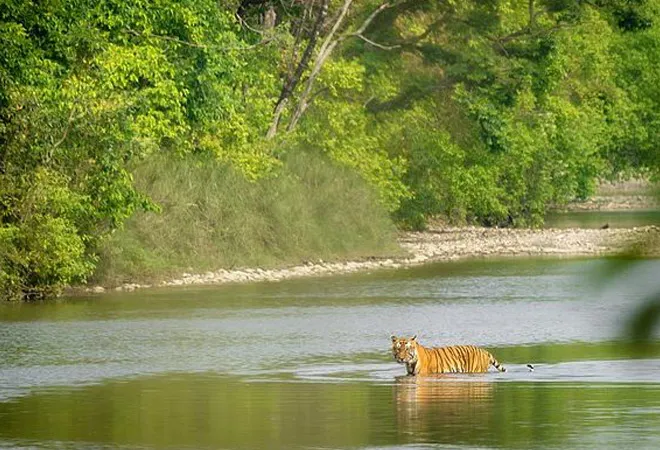
On 18 December 2022, the 15
th Conference of Parties to the Convention on Biological Diversity,
adopted the Kunming-Montreal Global Biodiversity Framework (GBF) towards furthering its effort on biodiversity conservation, setting out four visions for 2050 and 23 targets to be achieved by 2030. Through this article, we focus on Target 3 of the framework on area-based conservation, primarily protected areas. It will analyse the rights of forest-dwelling communities in India.
The International Union for Conservation of Nature (IUCN) categorises
Protected Areas (PA) into six types, defining them on the basis of governance structures and land use patterns, depending on their biological significance and the degree of conservation required. In India, the Wildlife Protection Act (WLPA) was legislated in 1972, making it Independent India’s first unified law for the protection of wildlife. Until then, such areas were being protected under provincial wildlife laws, primarily aimed towards regulating game hunting rather than conservation
<1>.
In India, the Wildlife Protection Act (WLPA) was legislated in 1972, making it Independent India’s first unified law for the protection of wildlife.
As per the WLPA, there are five PA categories, with varying governance structures, i.e., National Parks (NP), Wildlife Sanctuaries (WLS), Conservation Reserves, Community Reserves, and Tiger Reserves (TR). The table below highlights the number of protected areas in the country and their total area.
Table 1: Protected Areas in India (as on January 2023)
| Protected Area |
Number |
Total area (in sq. Km.) |
% coverage of total geographic area |
| Wildlife Sanctuaries |
567 |
1,22,564.86 |
3.73 |
| National Parks |
106 |
44,402.95 |
1.35 |
| Conservation Reserves |
105 |
5,206.55 |
0.16 |
| Community Reserves |
220 |
1,455.16 |
0.04 |
| Tiger Reserves<2> |
53 |
75,796.83 |
2.3 |
| Total |
998 |
1,73,629 |
5.28 |
Source-
wiienvis.nic.in ,
ntca.gov.in
While the numbers of Pas have increased substantially, the process of notifying such areas has been skewed and, in many cases, due process is not followed as laid down under the Act, especially the notification of tiger reserves. Since its inception in 1973 as a Centrally Sponsored Scheme, ‘
Project Tiger’ has been India’s flagship conservation policy. It was passed as an administrative category to protect the rapidly dwindling population of tigers in the country just one year after the passing of the WLPA. Nine national parks
<3> were declared as tiger reserves, with the numbers gradually increasing over the years. Since 2006, when Project Tiger was formally included under the WLPA, the number has increased to 53.
However, the implementation of the act has largely been carried out without following the due process as laid down under the act. The core area or Critical Tiger Habitats (CTH) of 27 TRs was hurriedly notified in 2007, immediately after the promulgation of the Act, without any study being carried out to assess whether these areas were suitable for tigers. Similarly, in buffer zones—areas that are peripheral to the core areas, providing a transitional space between the CTH and non-PAs—it was observed that consultations and consent of the concerned Gram Sabhas were not obtained. In 2012, 10 states hurriedly notified the buffer zones of their respective tiger reserves as a result of a Supreme Court order
<4>.
The core area or Critical Tiger Habitats (CTH) of 27 TRs was hurriedly notified in 2007, immediately after the promulgation of the Act, without any study being carried out to assess whether these areas were suitable for tigers.
Another law that stipulates for protection of wildlife is the Scheduled Tribes and Other Traditional Forest Dwellers (Recognition of Forest rights) Act, 2006, which allows for the creation of Critical Wildlife Habitats (CWH) under Section 4 (2) of the Act, also laying down certain prerequisites (4 (2 a-f)) for its notification. CWHs are defined as areas within national parks and sanctuaries that have been established through scientific and objective criteria that needs to be kept inviolate for the purpose of wildlife conservation
<5>. Section 4(2) also states that areas declared as CWH may not be diverted by the state or central government for any other purpose, thereby ensuring that such areas remain protected.
However, only one state—Maharashtra—has begun the implementation process in the country. A
report by ATREE and Kalpavriksh on the ongoing CWH process in Maharashtra highlighted the fallacies in the overall declaration process. Some of the major deviations in the procedure were that, in most of the PAs, the process of recognition of rights of forest-dwelling communities was incomplete; and the claims of the Forest Department in the ongoing case in Mumbai High Court, that 25 PAs did not have any habitations and therefore did not require rights recognition processes to be carried out, which proved to be false, etc.. Continuation of the declaration of CWH in such a manner would lead to irreversible damage to the rights and livelihoods of more than 1,000 villages living in and around the 55 PAs in the state. In June 2022, the State Board of Wildlife of Maharashtra
approved proposals for the declaration of 10 PAs in the state as CWH.
The major issues have been the coerced manner in which communities have been asked to relocate without following the principles of ‘Free Prior Informed Consent’.
A major drawback of the exclusionary conservation regime in India has been the displacement of communities through relocations and evictions. Documentary evidence shows displacements dating back to 1908 from the
Kaziranga reserve in Assam. However, the process has become more formal under the WLPA. A study by Kalpavriksh and Environmental Justice Atlas showed that the number of families displaced from 26 protected areas in India from 1999 to 2021 was approximately
13,500 families. The major issues have been the coerced manner in which communities have been asked to relocate without following the principles of ‘Free Prior Informed Consent’. In many cases, such as Achanakmar Tiger Reserve, Melghat Tiger Reserve, Panna Tiger Reserve, and Similipal Tiger Reserve, amongst others, the compensation given to the communities has been less than adequate. This has led to the worsening of the communities’ conditions than it was before relocation. In the case
of Bhoramdeo Wildlife Sanctuary, seven to eight villages were relocated in 2007-09 under the pretext of declaring the area as a tiger reserve. The WLS has not been notified as a tiger reserve and the communities are yet to receive any form of compensation even after more than a decade of being displaced. The proposal was eventually dropped in
2018 by the state government.
The status of communities’ post relocation also paints a grim picture.
According to a Central Empowered Committee report in the T.N Godavarman vs Union of India case, of the 177 families that have been relocated from tiger reserves, around 122 have been rehabilitated to forest lands, and the remaining 55 are on revenue lands. Of the 122 villages, only 42 villages have land status that have been converted. This shows that despite several decades after being relocated “voluntarily”, the communities continue to face several types of restrictions, with no access to government welfare schemes due to restrictions imposed on the use of forest lands.
The GBF highlights a significant change in conservation discourse towards the recognition of the rights of indigenous communities over their land and the inclusion of these communities in biodiversity conversation planning, decision making, and management processes.
In Corbett Tiger Reserve, the relocation of four villages from the south-eastern side of the tiger reserve has also been the same. While three villages were relocated in 1993-94, the creation of the new state of Uttarakhand in 2002 and the reorganisation of the state and district boundaries have left the communities entangled in official processes, with the status of land remaining unchanged for close to three decades. The villagers stated that corruption from district and tehsil officials during the relocation and post-relocation verification processes have also been factors for their land status not being recognised. A case has been filed in the Nainital High Court citing discrepancies in the overall process and criminal proceedings against the concerned officials.
Despite poor implementation, we see that more processes of displacement are being pushed by the states and forest bureaucracy to create exclusionary protected areas. India also lags far behind in terms of the attempts to explore co-management options of conservation. The GBF highlights a significant change in conservation discourse towards the recognition of the rights of indigenous communities over their land and the inclusion of these communities in biodiversity conversation planning, decision making, and management processes. However, the challenge lies in including such guidelines within the existing framework of biodiversity conservation especially in the context of PA governance in India. The existing exclusionary conservation policies as well as poor implementation raise the question of whether India can achieve the GBF goals, not just on paper but on the ground, where the actual conservation happens.
Akshay Chettri is a member of Kalpavriksh Environment Action Group.
<1> To hunt or not to hunt: Tiger hunting, conservation and collaboration in Colonial India, Rajashri Mitra,
International Journal for History, Culture and Modernity, HCM 2019, Vol. 7
<2> Tiger Reserves are an overlay category to National Parks and Wildlife Sanctuaries therefore do not feature in the total figures.
<3> Corbett NP, Kanha NP, Bandipur NP, Manas NP, Palamau NP, Melghat NP, Sunderbans NP and Simlipal NP
<4> Ajay Dubey vs National Tiger Conservation Authority, SLP (C) No. 21339/2011 dated 3
rd April 2012.
<5> Section 2(b) of the Forest Rights Act, 2006
The views expressed above belong to the author(s). ORF research and analyses now available on Telegram! Click here to access our curated content — blogs, longforms and interviews.



 On 18 December 2022, the 15th Conference of Parties to the Convention on Biological Diversity,
On 18 December 2022, the 15th Conference of Parties to the Convention on Biological Diversity,  PREV
PREV


